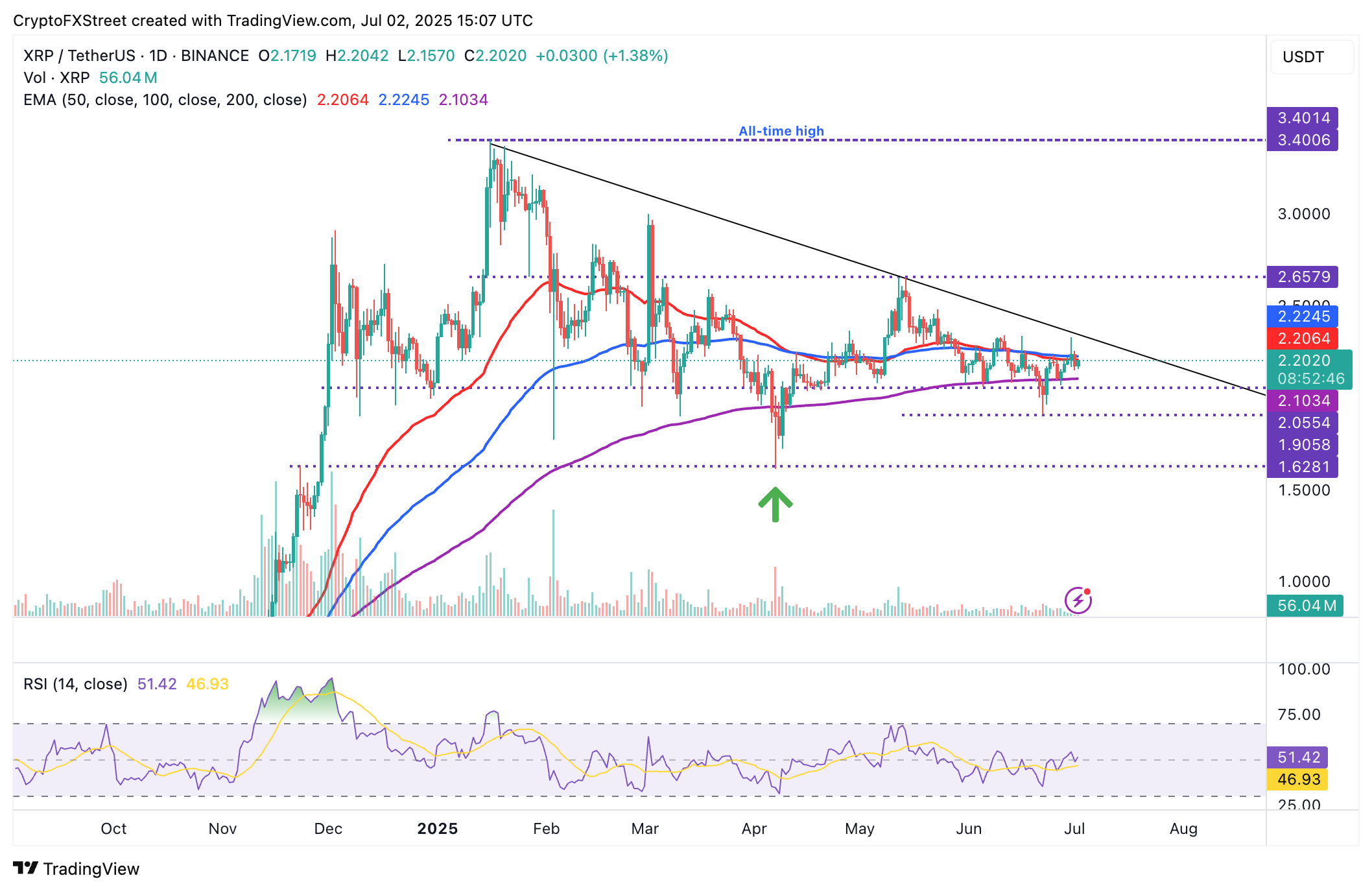Ripple Price Forecast: XRP flaunts optimistic technical structure as Ripple expands stablecoin transfers
- XRP consolidates below the 50-day EMA resistance at $2.20 amid prolonged market indecision.
- Ripple has signed a strategic partnership with OpenPayd, integrating Ripple Payments with the Euro and the Pound Sterling.
- The collaboration allows Ripple to leverage the OpenPayd global network, advancing compliant, efficient and scalable institutional-grade payments.
Ripple (XRP) extends its sideways trading, hovering at around $2.18 on Wednesday. Recovery has largely been limited despite Ripple’s announcement of stablecoin expansion and the advancements made on the XRP Ledger, which integrated the XRPL EVM Sidechain on Monday.
Meanwhile, interest in XRP remains slightly elevated at $4.16 billion, according to the futures contracts Open Interest (OI) data from CoinGlass. According to the chart below, the OI has recovered from the drop to $3.54 billion on June 23. Still, it remains significantly lower than the peaks of $5.52 billion on May 14 and $7.86 billion on January 18.

XRP futures Open Interest chart | Source: CoinGlass
Ripple advances stablecoin infrastructure and reach
Ripple has announced a strategic partnership with OpenPayd, a prominent provider of financial infrastructure, aiming to expand cross-border payments by integrating fiat currencies such as the Euro (EUR) and the Pound Sterling (GBP), as well as Ripple Payments.
The partnership comes a few weeks after OpenPayd launched a stablecoin infrastructure. Its multi-currency financial system supports real-time payment rails and virtual IBANs.
“The future of global finance depends on seamless interoperability between traditional infrastructure and digital assets,” Jack McDonald, Ripple’s SVP, Stablecoins, said.
Using OpenPayd infrastructure, Ripple will mint and burn the RLUSD stablecoin. At the same time, seamlessly move assets between fiat currencies and RLUSD by accessing OpenPayd’s full suite of services, including payments, embedded accounts, and trading, all under a single API.
Ripple’s partnership with OpenPayd will span several use cases, including cross-border transfers, treasury management, and access to US Dollar (USD) liquidity.
“This partnership enables businesses to move and manage money globally, access stablecoin liquidity at scale, and simplify cross border payments, treasury flows and dollar-based operations,” CEO of OpenPayd, Iana Dimitrova, said.
Technical outlook: XRP could resume bullish momentum
XRP’s sideways trading continues below the 50-day Exponential Moving Average (EMA), currently at $2.20. Slightly above it is the 100-day EMA at $2.22, which may be adding downward pressure.
The Relative Strength Index (RSI) position at 50 affirms the indecision in the market. Traders will look for movement toward overbought territory to ascertain bullish momentum and increase exposure to XRP.
If the price of XRP breaks above the descending trendline, as shown on the daily chart below, optimism for a larger breakout could boost risk-on sentiment. Key areas of interest above the trendline are the highest point in June at $2.34 and May’s peak at $2.65.

XRP/USDT daily chart
On the flip side, there’s a chance XRP could resume the downtrend, especially if the 50-day EMA at $2.20 and the 100-day EMA at $2.22 hurdles fail to give way. Therefore, the areas to monitor on the downside include the 200-day EMA support at $2.10, the demand area at $1.90 and April’s lowest price level at $1.61.
Ripple FAQs
Ripple is a payments company that specializes in cross-border remittance. The company does this by leveraging blockchain technology. RippleNet is a network used for payments transfer created by Ripple Labs Inc. and is open to financial institutions worldwide. The company also leverages the XRP token.
XRP is the native token of the decentralized blockchain XRPLedger. The token is used by Ripple Labs to facilitate transactions on the XRPLedger, helping financial institutions transfer value in a borderless manner. XRP therefore facilitates trustless and instant payments on the XRPLedger chain, helping financial firms save on the cost of transacting worldwide.
XRPLedger is based on a distributed ledger technology and the blockchain using XRP to power transactions. The ledger is different from other blockchains as it has a built-in inflammatory protocol that helps fight spam and distributed denial-of-service (DDOS) attacks. The XRPL is maintained by a peer-to-peer network known as the global XRP Ledger community.
XRP uses the interledger standard. This is a blockchain protocol that aids payments across different networks. For instance, XRP’s blockchain can connect the ledgers of two or more banks. This effectively removes intermediaries and the need for centralization in the system. XRP acts as the native token of the XRPLedger blockchain engineered by Jed McCaleb, Arthur Britto and David Schwartz.

